Port Authority of New York and New Jersey: Difference between revisions
No edit summary |
→Governance: Updating the list of commissioners. Formatting as bullets for easier maintenance in future years. |
||
| Line 75: | Line 75: | ||
== Governance == |
== Governance == |
||
The Port Authority is jointly headed by the governors of New York and [[Governor of New Jersey|New Jersey]]. Each governor, with the approval of his or her state senate, appoints six members to the [[Board of Commissioners]], who serve overlapping six-year terms without pay.<ref name="PANYNJ-annual-report-2002"/> As of |
The Port Authority is jointly headed by the governors of New York and [[Governor of New Jersey|New Jersey]]. Each governor, with the approval of his or her state senate, appoints six members to the [[Board of Commissioners]], who serve overlapping six-year terms without pay.<ref name="PANYNJ-annual-report-2002"/> As of March 2012, the appointed commissioners are as follows:<ref>[http://www.panynj.gov/corporate-information/board-commissioners.html The Port Authority of New York & New Jersey - Board of Commissioners]</ref> |
||
* David Samson (NJ, Chairman) |
|||
* Scott H. Rechler (NY, Vice-Chairman) |
|||
* Virginia S. Bauer (NJ) |
|||
* H. Sidney Holmes III (NY) |
|||
* Jeffrey H. Lynford (NY) |
|||
* Jeffrey A. Moerdler (NY) |
|||
* Raymond M. Pocino (NJ) |
|||
* Anthony J. Sartor, Ph.D., P.E., P.P. (NJ) |
|||
* William "Pat" Schuber, Esq., BA, JD (NJ) |
|||
* Henry R. Silverman (NY) |
|||
* David S. Steiner (NJ) |
|||
A governor can veto actions by the commissioners from the same state.<ref>{{cite web|url=http://www.panynj.gov/AboutthePortAuthority/Governance/BoardofCommissioners/|title=Board of Commissioners|publisher=Port Authority of New York and New Jersey|accessdate=2008-09-28 |archiveurl = http://web.archive.org/web/20080630000920/http://www.panynj.gov/AboutthePortAuthority/Governance/BoardofCommissioners/ <!-- Bot retrieved archive --> |archivedate = 2008-06-30}}</ref> Meetings of the Board of Commissioners are public. Members of the Board of Commissioners are typically business titans and political power brokers who maintain close relationships with their respective Governors. On February 3, 2011, Former New Jersey Attorney General David Samson was named new chairman of the Port Authority.<ref>{{cite web|url=http://www.nypost.com/p/news/local/pa_gets_new_chairman_e9sFBMlHOTpu6XJKlsyUgL#ixzz1D0JwhSxB|title=PA Gets New Chairman|publisher=NY Post|accessdate=2011-02-04}}</ref> |
|||
Financially, the Port Authority has no power to tax and does not receive tax money from any local or state governments. Instead, it operates on the revenues it makes from its rents, tolls, fees, and facilities.<ref>{{cite web|url=http://www.panynj.gov/AboutthePortAuthority/Governance/ |title=Governance|publisher=Port Authority of New York and New Jersey|accessdate=2008-09-28 |archiveurl = http://web.archive.org/web/20080714211343/http://www.panynj.gov/AboutthePortAuthority/Governance/ <!-- Bot retrieved archive --> |archivedate = 2008-07-14}}</ref> |
Financially, the Port Authority has no power to tax and does not receive tax money from any local or state governments. Instead, it operates on the revenues it makes from its rents, tolls, fees, and facilities.<ref>{{cite web|url=http://www.panynj.gov/AboutthePortAuthority/Governance/ |title=Governance|publisher=Port Authority of New York and New Jersey|accessdate=2008-09-28 |archiveurl = http://web.archive.org/web/20080714211343/http://www.panynj.gov/AboutthePortAuthority/Governance/ <!-- Bot retrieved archive --> |archivedate = 2008-07-14}}</ref> |
||
Revision as of 21:14, 16 March 2012
| Formation | 1921 |
|---|---|
| Type | Port district |
| Headquarters | Corporate Headquarters The Port Authority of NY & NJ |
Region served | New York and New Jersey |
Executive Director | Patrick J. Foye |
| Website | Port Authority of New York and New Jersey - Official Website |


The Port Authority of New York and New Jersey (PANYNJ) is a bi-state port district authority, established in 1921 (as the Port of New York Authority) through an interstate compact, that runs most of the regional transportation infrastructure, including the bridges, tunnels, airports, and seaports, within the Port of New York and New Jersey. This 1,500 square mile (3,900 km²) District is a region generally within 25 miles (40 km) of the Statue of Liberty in New York Harbor.[1] The Port Authority is headquartered at 225 Park Avenue South in Manhattan.[2]
The Port Authority operates the Port Newark-Elizabeth Marine Terminal, which handled the third largest amount of shipping of all ports in the United States in 2004 and the largest on the Eastern Seaboard.[3] The Port Authority also operates Hudson River crossings, including the Holland Tunnel, Lincoln Tunnel, and George Washington Bridge connecting New Jersey with Manhattan, and three crossings that connect New Jersey with Staten Island. The Port Authority Bus Terminal and the PATH rail system are also run by the Port Authority, as well as LaGuardia Airport, John F. Kennedy International Airport, Newark Liberty International Airport, Teterboro Airport and Stewart International Airport. The agency has its own 1,600-member Port Authority Police Department, which is responsible for providing safety and deterring criminal activity at Port Authority–owned-and-operated facilities.[4]
Although the Port Authority manages much of the transportation infrastructure in the area, most bridges, tunnels, and other transportation facilities are not included. The New York City Department of Transportation is responsible for the Staten Island Ferry and for the majority of bridges in the city. The Triborough Bridge and Tunnel Authority is responsible for other bridges and tunnels in the area. New York City Transit Authority buses and subways, Metro North and Long Island Rail Road, and buses, commuter rail, and light rail operated by New Jersey Transit are also independent of PANYNJ.
History
In the early years of the 20th century, there were disputes between the states of New Jersey and New York, over rail freights and boundaries. At the time, rail lines terminated on the New Jersey side of the harbor, while ocean shipping was centered on Manhattan and Brooklyn. Freight had to be shipped across the Hudson River in barges.[5] In 1916, New Jersey launched a lawsuit against New York over issues of rail freight, with the Interstate Commerce Commission (ICC) issuing an order that the two states work together, subordinating their own interests to the public interest.[6] The Harbor Development Commission, a joint advisory board set-up in 1917, recommended that a bi-state authority be established to oversee efficient economic development of the port district.[7] The Port of New York Authority was established on April 30, 1921,[8] through an interstate compact between the states of New Jersey and New York. This was the first such agency in the United States, created under a provision in the Constitution of the United States permitting interstate compacts.[1][9] The idea for the Port Authority was conceived during the Progressive Era, which aimed at the reduction of political corruption and at increasing the efficiency of government. With the Port Authority at a distance from political pressures, it was able to carry longer-term infrastructure projects irrespective of the election cycles and in a more efficient manner.[10] Throughout its history, there have been concerns about democratic accountability, or lack thereof at the Port Authority.[10] The Port District is irregularly shaped but comprises a 1,500-square-mile (3,900 km2) area roughly within a 25-mile (40 km) radius of the Statue of Liberty.
Interstate crossings

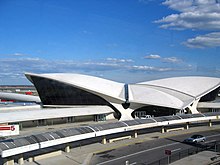
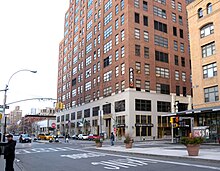
At the beginning of the 20th century, there were no road bridge or tunnel crossings between the two states. Under an independent agency, the Holland Tunnel was opened in 1927, with some planning and construction pre-dating the Port Authority. With the rise in automobile traffic, there was demand for more Hudson River crossings. Using its ability to issue bonds and collect revenue, the Port Authority has built and managed major infrastructure projects. Early projects included bridges across the Arthur Kill, which separates Staten Island from New Jersey.[8] The Goethals Bridge, named after chief engineer of the Panama Canal Commission General George Washington Goethals, connected Elizabeth, New Jersey and Howland Hook, Staten Island. At the south end of Arthur Kill, the Outerbridge Crossing was built and named after the Port Authority's first chairman, Eugenius Harvey Outerbridge.[11] Construction of both bridges was completed in 1928. The Bayonne Bridge, opened in 1931, was built across the Kill van Kull, connecting Staten Island with Bayonne, New Jersey.[12]
Construction began in 1927 on the George Washington Bridge, linking the northern part of Manhattan with Fort Lee, New Jersey, with Port Authority chief engineer, Othmar Ammann, overseeing the project.[8] The bridge was completed in October 1931, ahead of schedule and well under the estimated costs. This efficiency exhibited by the Port Authority impressed President Franklin D. Roosevelt, who used this as a model in creating the Tennessee Valley Authority and other such entities.[10]
In 1930, the Holland Tunnel was placed under control of the Port Authority, providing significant toll revenues to the Port Authority.[12] During the late 1930s and early 1940s, the Lincoln Tunnel was built, connecting New Jersey and Midtown Manhattan.
Austin J. Tobin era
Airports
In 1942, Austin J. Tobin became the Executive Director of the Port Authority. In the post-World War II period, the Port Authority expanded its operations to include airports, and marine terminals, with projects including Newark Liberty International Airport and Port Newark-Elizabeth Marine Terminals. Meanwhile, the city-owned La Guardia Field, was nearing capacity in 1939, and needed expensive upgrades and expansion. At the time, airports were operated as loss leaders, and the city was having difficulties maintaining the status quo, losing money and not able to undertake needed expansions.[13] The city was looking to hand the airports over to a public authority, possibly to Robert Moses' Triborough Bridge and Tunnel Authority. After long negotiations with the City of New York, a 50-year lease, commencing on May 31, 1947, went to the Port Authority of New York to rehabilitate, develop, and operate La Guardia Airport (La Guardia Field), John F. Kennedy International Airport (Idlewild Airport), and Floyd Bennett Field.[8][14] The Port Authority transformed the airports into fee-generating facilities, adding stores and restaurants.[13]
World Trade Center
David Rockefeller, president of Chase Manhattan Bank, who envisioned a World Trade Center for lower Manhattan, realizing he needed public funding in order to construct the massive project, approached Tobin. Although many questioned the Port Authority's entry into the real estate market, Tobin saw the project as a way to enhance the agency's power and prestige, and agreed to the project. The Port Authority was the overseer of the World Trade Center, hiring the architect Minoru Yamasaki and engineer Leslie Robertson.
Yamasaki ultimately settled on the idea of twin towers. To meet the Port Authority's requirement to build 10 million square feet (930,000 m²) of office space, the towers would each be 110-stories tall. The size of the project raised ire from the owner of the Empire State Building, which would lose its title of tallest building in the world.[12] Other critics objected to the idea of this much "subsidized" office space going on the open market, competing with the private sector. Others questioned the cost of the project, which in 1966 had risen to $575 million.[12] Final negotiations between The City of New York and the Port Authority centered on tax issues. A final agreement was made that the Port Authority would make annual payments in lieu of taxes, for the 40% of the World Trade Center leased to private tenants. The remaining space was to be occupied by state and federal government agencies. In 1962, the Port Authority had signed up the United States Customs Service as a tenant, and in 1964 they inked a deal with the State of New York to locate government offices at the World Trade Center.[citation needed]
In August 1968, construction on the World Trade Center's north tower started, with construction on the south tower beginning in January 1969.[15] When the World Trade Center twin towers were completed, the total costs to the Port Authority had reached $900 million.[16] The buildings were dedicated on April 4, 1973, with Tobin, who had resigned the year before, absent from the ceremonies.[17]
September 11, 2001 attacks
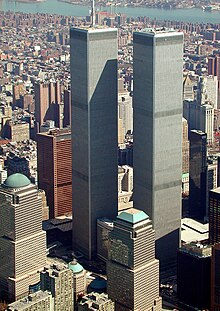
The terrorist attacks of September 11, 2001, and the subsequent collapse of the World Trade Center buildings impacted the Port Authority. With the Port Authority's headquarters located in 1 World Trade Center, it became deprived of a base of operations and sustained a great number of casualties. An estimated 1,400 Port Authority employees worked in the World Trade Center.[18] The Port Authority lost a total of 84 employees, including 37 Port Authority police officers, its Executive Director, Neil D. Levin, and police superintendent, Fred V. Morrone.[19] In rescue efforts following the collapse, two Port Authority police officers, John McLoughlin and Will Jimeno, were pulled out alive after spending nearly 24 hours beneath 30 feet (9.1 m) of rubble.[20][21] Their rescue was later portrayed in the Oliver Stone film World Trade Center.
Governance
The Port Authority is jointly headed by the governors of New York and New Jersey. Each governor, with the approval of his or her state senate, appoints six members to the Board of Commissioners, who serve overlapping six-year terms without pay.[1] As of March 2012, the appointed commissioners are as follows:[22]
- David Samson (NJ, Chairman)
- Scott H. Rechler (NY, Vice-Chairman)
- Virginia S. Bauer (NJ)
- H. Sidney Holmes III (NY)
- Jeffrey H. Lynford (NY)
- Jeffrey A. Moerdler (NY)
- Raymond M. Pocino (NJ)
- Anthony J. Sartor, Ph.D., P.E., P.P. (NJ)
- William "Pat" Schuber, Esq., BA, JD (NJ)
- Henry R. Silverman (NY)
- David S. Steiner (NJ)
A governor can veto actions by the commissioners from the same state.[23] Meetings of the Board of Commissioners are public. Members of the Board of Commissioners are typically business titans and political power brokers who maintain close relationships with their respective Governors. On February 3, 2011, Former New Jersey Attorney General David Samson was named new chairman of the Port Authority.[24]
Financially, the Port Authority has no power to tax and does not receive tax money from any local or state governments. Instead, it operates on the revenues it makes from its rents, tolls, fees, and facilities.[25]
An Executive Director is appointed by the Board of Commissioners to deal with day-to-day operations and to execute the Port Authority's policies. Patrick J. Foye became Executive Director on November 1, 2011. Prior to joining the Port Authority, he served as Deputy Secretary for Economic Development for Governor Andrew M. Cuomo.

Former Executive Directors
- John E. Ramsey (1926-1942)
- Austin J. Tobin (1942–1972)
- Matthias Lukens (acting,1972-1973)
- A. Gerdes Kuhbach (1973-1977; acting 1973-74)
- Peter C. Goldmark (1977-1985)
- Patrick J. Falvey (acting, 1985)
- Stephen Berger (1985-1990)
- Stanley Brezenoff (1990-1995)
- George Marlin (1995-1997)
- Robert E. Boyle (1997-2001)
- Neil D. Levin (March 2001-Sept. 11, 2001)
- Joseph J. Seymour (2002-2004)
- Kenneth J. Ringler, Jr.[26] (2004-2006)
- Anthony Shorris (2006-2008)
- Christopher O. Ward (2008-2011)
- Patrick J. Foye (2011-Present)
Facilities
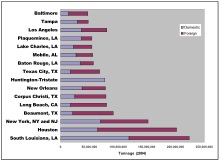
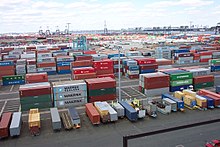

The Port Authority of New York and New Jersey manages and maintains infrastructure critical to the New York/New Jersey region’s trade and transportation network—five of the region’s airports, the New York/New Jersey seaport, the PATH rail transit system, six tunnels and bridges between New York and New Jersey, the Port Authority Bus Terminal in Manhattan and The World Trade Center site.[27]
Seaports
The Port of New York and New Jersey is the largest port complex on the East Coast of North America and is located at the hub of the most concentrated and affluent consumer market in the world, with immediate access to the most extensive interstate highway and rail networks in the region. In addition, The Port Authority directly oversees the operation of seven cargo terminals in the New York–New Jersey region. Each terminal offers comprehensive shipping services, rail and trucking services.
The Port Authority operates the following seaports:[27]
- Port Jersey Marine Terminal in Bayonne and Jersey City
- Brooklyn Port Authority Marine Terminal (a combined terminal of Brooklyn Piers and Red Hook Container Terminal) in Red Hook, Brooklyn, NY
- Howland Hook Marine Terminal on Staten Island.
- Port Newark-Elizabeth Marine Terminal in Newark and Elizabeth.
The Port Newark-Elizabeth Marine Terminal was the first in the nation to containerize,[28] As of 2004, Port Authority seaports handle the third largest amount of shipping of all U.S. ports, as measured in tonnage.[3]
Airports
The Port Authority operates the following airports:[27]
- John F. Kennedy International Airport (Queens, New York)
- LaGuardia Airport (Queens, New York)
- Newark Liberty International Airport (Newark and Elizabeth, New Jersey)
- Stewart International Airport, (Newburgh, New York)
- Teterboro Airport (Teterboro, New Jersey)
Both Kennedy and LaGuardia airports are owned by the City of New York and leased to the Port Authority for operating purposes. Newark Liberty is owned by the City of Newark and also leased to the Authority. In 2007, Stewart International Airport, owned by the State of New York, was leased to the Port Authority.
Heliports
The Authority operates the Downtown Manhattan Heliport (Manhattan, New York).[27]
Bridges and tunnels
Other facilities managed by the Port Authority include the George Washington Bridge, the Lincoln Tunnel, and the Holland Tunnel, which all connect Manhattan and northern New Jersey; the Goethals Bridge, the Bayonne Bridge, and the Outerbridge Crossing which connect Staten Island and New Jersey.
Bus and rail transit

The Port Authority operates the Port Authority Trans-Hudson (PATH) rapid transit system linking lower and midtown Manhattan with New Jersey, the AirTrain Newark system linking Newark International Airport with New Jersey Transit and Amtrak via a station on the Northeast Corridor rail line, and the AirTrain JFK system linking JFK with Howard Beach (Subway) and Jamaica (Subway and Long Island Rail Road).[27]
Major bus depots include the Port Authority Bus Terminal at 42nd Street, the George Washington Bridge Bus Station, and the Journal Square Transportation Center in Jersey City.
Real estate
The Port Authority also participates in joint development ventures around the region, including The Teleport communications center on Staten Island, Bathgate Industrial Park in The Bronx, the Essex County Resource Recovery Facility, The Legal Center in Newark, Queens West in Long Island City, NY, and The South Waterfront in Hoboken, New Jersey.[27]
Current and future projects
Major projects by the Port Authority include the One World Trade Center and other construction at the World Trade Center site. Other projects include a new passenger terminal at JFK International Airport, and redevelopment of Newark Liberty International Airport's Terminal B, and replacement of the Goethals Bridge.[29] The Port Authority also has plans to buy 340 new PATH cars and begin major expansion of Stewart International Airport.[29]
World Trade Center site
As owner of the World Trade Center site, the Port Authority has worked since 2001 on plans for reconstruction of the site, along with Silverstein Properties, and the Lower Manhattan Development Corporation. In 2006, the Port Authority reached a deal with Larry Silverstein, which ceded control of One World Trade Center to the Port Authority.[30] The deal gave Silverstein rights to build three towers along the eastern side of the site, including 150 Greenwich Street, 175 Greenwich Street, and 200 Greenwich Street.[30] Also part of the plans, is the World Trade Center Transportation Hub, which will replace the temporary PATH station that opened in November 2003.
Atlantic City International Airport takeover
In March 2011, Port Authority officials considered taking over operations of the Atlantic City International Airport in Egg Harbor Township, New Jersey outside Atlantic City. The airport, operated by the South Jersey Transportation Authority on land leased by the FAA, would be turned over to the Port Authority in a similar manner to the takeover of Stewart Airport.[31][32]
Police force
The Port Authority has its own police force that provides police services to the Port Authority. The department currently employs approximately 1,600 police officers and supervisors who have full police status in New York and New Jersey.
See also
- Mass transit in New York City
- Port authority
- Transportation in New York City
- Waterfront Commission of New York Harbor
References
- ^ a b c "2002 Annual Report" (PDF). PANY. 2003.
- ^ "Contact Information." Port Authority of New York and New Jersey. Retrieved on April 15, 2009.
- ^ a b c "Tonnage for Selected U.S. Ports in 2004". U.S. Army Corps of Engineers, Navigation Data Center. Retrieved 2006-10-04.
- ^ "Port Authority Announces Police Promotions". PANYNJ. November 6, 2003.
- ^ Rodrigue, Jean Paul (2004). "Chapter 4, Appropriate models of port governance Lessons from the Port Authority of New York and New Jersey". Shipping and Ports in the Twenty-first Century. Routledge.
- ^ Darton, Eric (1999). "Chapter 1". Divided We Stand: A Biography of New York's World Trade Center. Basic Books.
- ^ Revell, Keith D. (2000). "Cooperation, Capture, and Autonomy: The Interstate Commerce Commission and the Port Authority in the 1920s". Journal of Policy History. 12 (2): 177–214. doi:10.1353/jph.2000.0014.
- ^ a b c d "History of the Port Authority". PANY. Archived from the original on 2006-09-29. Retrieved 2006-09-30.
- ^ Broun, Caroline N.; Buenger, Michael L.; McCabe, Michael H.; Masters, Richard L. (2006). The evolving use and the changing role of interstate compacts: a practitioner's guide (Google books preview). Chicago: American Bar Association. p. 368. ISBN 1-59031-643-6. Retrieved September 20, 2011.
- ^ a b c Doig, Jameson W. (2001). "Chapter 1". Empire on the Hudson. Columbia University Press.
- ^ "E. H. Outerbridge, Port Expert, Dies. Head Of Export And Import Firm And Ex-Chairman Of Port Of New York Authority. Aided Major Harbor. Comprehensive Development Started in His Term Of Office twice. Chamber Of Commerce Head". The New York Times. November 11, 1932. p. 19. Retrieved 2008-03-09.
Eugenius H. Outerbridge, head of the firm of Harvey Outerbridge and former chairman of the Port of New York Authority, died yesterday in the New York ...
{{cite news}}: Cite has empty unknown parameter:|coauthors=(help) - ^ a b c d Gillespie, Angus K. (1999). "Chapter 1". Twin Towers: The Life of New York City's World Trade Center. Rutgers University Press.
- ^ a b Lander, Brad (2002). "Land Use". Gotham Gazette. Retrieved 2006-10-03.
{{cite news}}: Unknown parameter|month=ignored (help) - ^ "NAME OF IDLEWILD TO BE CITY AIRPORT; Cullman Proposes the Change and O'Dwyer Promises His Aid in Making Shift ADDED PRESTIGE OBJECT Port Authority Head Turns Over to Mayor the Releases From 17 Old Contracts". The New York Times. May 30, 1947. p. 23. Retrieved 2010-07-18.
- ^ "Timeline: World Trade Center chronology". PBS - American Experience. Retrieved 2006-09-30.
- ^ Cudahy, Brian J. (2002). "Chapter 3". Rails Under the Mighty Hudson: The Story of the Hudson Tubes, the Pennsy Tunnels, and Manhattan Transfer. Fordham University Press.
- ^ Darton, Eric (1999). "Chapter 6". Divided We Stand: A Biography of New York's World Trade Center. Basic Books.
- ^ Kifner, John; Waldman, Amy (September 12, 2001). "A DAY OF TERROR: THE VICTIMS; Companies Scrambling to Find Those Who Survived, and Didn't". The New York Times. Retrieved 2010-07-18.
- ^ "2002 Annual Report" (PDF). PANYNJ.
- ^ Murphy, Dean E. (September 12, 2001). "A DAY OF TERROR: THE HOPES; Survivors Are Found In the Rubble". The New York Times. Retrieved 2010-07-18.
- ^ Filkins, Dexter (September 13, 2001). "AFTER THE ATTACKS: ALIVE; Entombed for a Day, Then Found". The New York Times. Retrieved 2010-07-18.
- ^ The Port Authority of New York & New Jersey - Board of Commissioners
- ^ "Board of Commissioners". Port Authority of New York and New Jersey. Archived from the original on 2008-06-30. Retrieved 2008-09-28.
- ^ "PA Gets New Chairman". NY Post. Retrieved 2011-02-04.
- ^ "Governance". Port Authority of New York and New Jersey. Archived from the original on 2008-07-14. Retrieved 2008-09-28.
- ^ "Kenneth J. Ringler, Jr". North Jersey Transportation Planning Authority, Inc. Retrieved 2006-10-04. [dead link]
- ^ a b c d e f "Facilities and Services". Port Authority of New York and New Jersey. Archived from the original on 2008-08-03. Retrieved 2008-09-28.
- ^ Doig, Jameson W. (2001). "Epilogue". Empire on the Hudson. Columbia University Press.
- ^ a b "2005 Annual Report" (PDF). PANYNJ.
- ^ a b Marsico, Ron (September 22, 2006). "Deal puts Freedom Tower in P.A. control". The Star-Ledger. Newark.
- ^ http://www.pressofatlanticcity.com/news/press/atlantic_city/local-state-federal-interests-in-atlantic-city-airport-complicate-sale/article_e7decfb6-79de-11e0-aa9c-001cc4c002e0.html Fletcher Juliet, Press of Atlantic City, Sunday, May 8, 2011
- ^ Steve Strunsky (2011-29-Mar). "Port Authority officials consider acquisition of Atlantic City International Airport". The Star Ledger. Retrieved 2011-31-Jul.
{{cite web}}: Check date values in:|accessdate=and|date=(help)
External links
- Port Authority of New York and New Jersey - Official Website
- History of the Port Authority
- Video of cornerstone laying ceremony for the Freedom Tower on July 4, 2004
- 1921 Map of Port Authority
- Intermodal transportation authorities in New York
- Intermodal transportation authorities in New Jersey
- Ports and harbors of New York
- Port Authority of New York and New Jersey
- Ports and harbors of New Jersey
- Public benefit corporations in New York
- Bridges in New York City
- Bridges in New York
- Bridges in New Jersey
- New Jersey law
- New York law
- United States interstate agencies
- United States interstate compacts
- Airport operators of the United States

